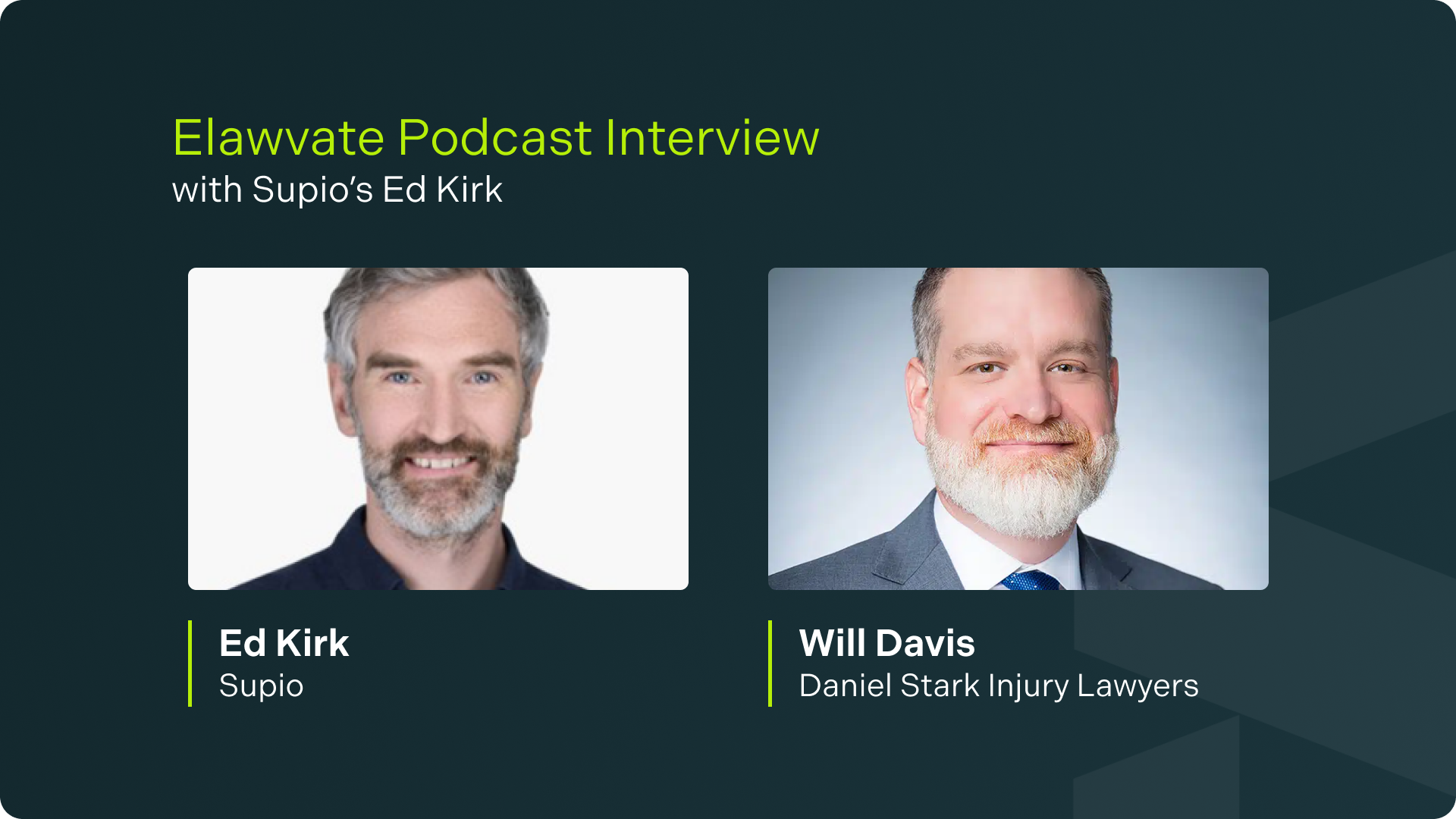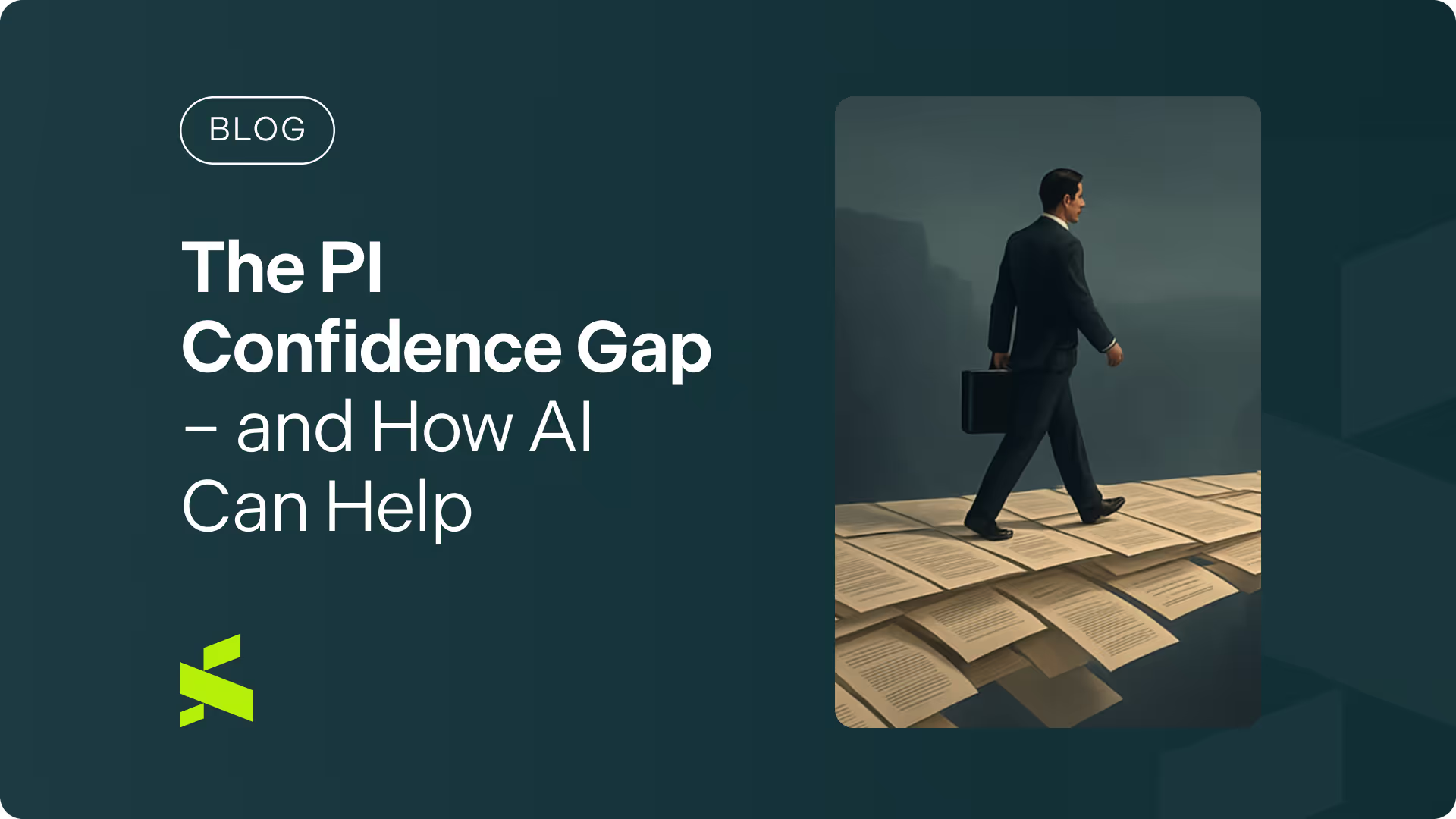Watch the full conversation on the Elawvate Podcast.
tl;dr
In a recent episode of the Elawvate Podcast, hosts Ben Gideon and Rahul Ravipudi sat down with Ed Kirk, Head of Partnerships at Supio, and Will Davis, Chief Legal Officer at Daniel Stark Injury Lawyers.
The conversation focused on how Supio, a legal AI platform built specifically for plaintiff trial lawyers, is changing the way firms handle medical records, build cases, and prepare for trial. Will shared what it looks like to run Supio inside a busy PI practice, while Ed explained how Supio’s approach to AI is different.
“Everything that it tells you, every output has a source.” – Will Davis
Distilled Q&A from the conversation
Q: Can you tell us about your backgrounds, your roles, and how you use Supio?
Will introduced himself as a partner and Chief Legal Officer at Daniel Stark Injury Lawyers, a Texas-based personal injury firm with six offices, 40 attorneys, and about 170 employees. At the time of recording, his firm has been using Supio for roughly 18 months after first getting involved with the project two years ago.
Davis explained that what began as an interest in AI for demand letters quickly shifted once he saw Supio’s interactive medical chronology and chatbot features. Those, he said, were “the difference” compared to other products at the time.
Ed shared that before joining Supio he practiced law for seven years, starting as a paralegal in London before moving into personal injury practice. In 2018, he shifted into legal tech, bringing a UK startup to North America and later selling it. That experience led him to Supio, where he joined as the twelfth employee. Today, he helps lead partnerships for a company that has grown to about 150 people.
Q: What is Supio, and how does it help plaintiff trial lawyers in practice?
Supio is often described as a “legal AI team,” a phrase Ed likes to use because it captures how the platform combines the roles of paralegal, nurse consultant, and attorney. It organizes medical records, creates a chronology, flags missing bills, and surfaces undiagnosed injuries or hidden insights that can change the trajectory of a case.
“Supio is that second pair of eyes,” Kirk added, “helping lawyers work up their cases more fully.”
The goal isn’t just speed, though attorneys immediately see efficiency gains. As Kirk put it, the deeper value comes from finding the hidden value in cases, giving trial lawyers a clearer story and pointing them toward arguments or injuries that might otherwise go unnoticed.
Q: How does Supio integrate into the way you manage your firm?
At Daniel Stark, every litigation case is set up in Supio as soon as it comes in. According to Will, the first step is uploading all medical bills and records, which the system then organizes into an interactive chronology. That foundation makes it easier for lawyers and paralegals to understand the medical picture, spot gaps, and identify issues that need further development.
Davis noted how useful this is for younger lawyers and staff. Instead of searching Google every time an unfamiliar medical term pops up, they can simply highlight the word in Supio and get an explanation on the spot. The platform also helps uncover overlooked issues (like a doctor’s referral that had been forgotten) which can change the direction of a case once addressed.
The tool’s role has since expanded beyond medical records. Davis explained that his firm now pushes discovery documents, deposition transcripts, and motions into Supio so everything can be searched and cross-referenced in one place. That makes time-consuming tasks like expert designations far faster. “What used to take a paralegal hours,” he said, “now takes 30 seconds.”
Supio even shows up at the trial table. Some of Davis’s colleagues keep it open during trial because it gives them instant access to every file, every transcript, and every chronology. And importantly, as Davis emphasized, “everything that it tells you, every output has a source” – with a clickable link back to the record itself.
Q: How does Supio compare to other AI platforms, and what makes it stand out?
When it comes to AI in law, Will drew a clear line between general-purpose tools like ChatGPT and a domain-specific system like Supio. At his firm, security was non-negotiable.
“We’re talking about medical information and attorney-client privileged information,” he explained. “I wanted to be 100% confident that it was safe and secure, HIPAA compliant.” That’s why Daniel Stark put an AI policy in place barring case-specific data from being entered into general tools, while allowing Supio for litigation work.
Ed framed Supio’s differentiator as depth of understanding. In his words, it’s “domain-specific AI” that is purpose-built for plaintiff injury law. Rather than just streaming text back like a general chatbot, it has been trained to read complex medical records, bills, and flow sheets, giving it a far more accurate grasp of the underlying case.
Both guests agreed that the future of AI in law isn’t about who can bolt on the flashiest features. It’s about accuracy, trust, and security. As Kirk put it: “Accuracy will win out.”
Q: How does Supio’s AI actually work, and how does it add value?
Ed explained that Supio’s core technology is something the company calls CaseAware AI (formerly Document Intelligence). Behind the user-friendly interface, the system uses layered processing to make sense of complex medical records. That includes text recognition, transcription of handwriting, and a process called annotation – which points the AI to the right data fields, like the true date of service, rather than a print or signature date.
The result is a structured data layer that powers Supio’s interactive chronologies. Lawyers can filter events by injury, provider, or facility, and quickly move from a high-level timeline down into the source document itself. That same layer also enables drafting tools, because the system has already reconciled dates, diagnoses, and billing details with a level of accuracy that general AI systems often miss.
“It’s that nuance and understanding that sets us apart,” Kirk said, noting that venture capital firms back Supio because of this underlying capability. Medical billing and record reconciliation are notoriously difficult for humans to do at scale, but Supio’s ability to process them consistently is the company’s moat.
Q: When lawyers work with Supio on medical records, does it improve the model? How does Supio get better over time?
Ed clarified that improvement comes less from end users “training” the system directly and more from Supio’s internal process of annotation and refinement. Human experts guide the AI by pointing it toward the right fields in different types of records – so the model consistently extracts the correct data.
Once records are processed, several layers of analysis run before a lawyer ever interacts with the file. Handwriting is flagged and transcribed, dates are standardized, and relevant fields are mapped. That structured data then powers Supio’s filterable chronologies, allowing attorneys to search by injury, event, or provider.
As Kirk put it, this isn’t just about organization. The data layer is also the “jumping off point” for drafting legal documents. By ensuring that the foundation is accurate, Supio can give lawyers outputs they can trust with every entry tied back to the original source record.
Q: If AI tools like Supio become fully integrated, could they become a crutch?
The concern, as host Ben Gideon put it, is whether younger lawyers or paralegals will lose the ability to read medical records themselves if they rely too heavily on AI.
Ed predicted that coaching features will become part of the solution. He expects future versions of Supio to include persona-based guidance – tailoring prompts and suggestions depending on whether the user is a paralegal, attorney, or managing attorney. That way, the system doesn’t just hand over answers but nudges users toward the right thought process.
Will added that some direct review will always be necessary, but he sees AI making it more strategic. In a hospital admission, for example, hundreds of pages of records might only contain a few pages of relevant information. Supio helps attorneys zero in on what matters without losing sight of the bigger picture. “You’re not going to take it all away,” he said. “You’re just going to make it more strategic.”
Q: When a vendor pitches a new AI product, what questions should lawyers ask to separate value from hype?
For both guests, security is the first test. “If they don’t know what HIPAA is or can’t explain how it’s secure, that would be a huge concern,” Will said.
Ed suggested pressing vendors to explain, in simple terms, how their system actually works.
“Think of me like a sixth grade student,” he said. “Explain it that way.” If a company can’t walk through how it creates a medical chronology or finds nuance in a catastrophic injury case, that’s a red flag.
Both also recommended digging into a vendor’s roadmap. In a fast-moving space, it matters whether a partner will evolve with your firm’s needs. Kirk added that firms should “grill your vendor about their roadmap” and make sure it aligns with their long-term goals, not just short-term hype.
Pressure-test legal AI vendors and protect your firm from generic tools. Get the checklist →
Davis cautioned against tools that are “all AI” with no human oversight. Those systems may boast speed, but even a slightly higher error rate is unacceptable in litigation. The better balance, he said, is a platform with enough human involvement in the training to keep error rates low, while still delivering speed and efficiency.
Q: What’s next on the Supio roadmap?
The roadmap, Ed explained, is focused on tools that directly support litigation. One example is same-day transcription from depositions or audio recordings. While not a substitute for the official transcript, it gives trial teams something they can work with immediately. In one wrongful death case, lawyers used real-time trial transcripts in Supio to respond to seven direct motions during trial, ultimately winning all of them on the way to a $21 million verdict.
Supio is also adding features to surface contradictions within records, bringing inconsistencies to eye level instead of requiring hours of manual review. On the mass tort and medical malpractice side, Kirk said the focus is on handling flow sheet data and helping firms manage complex, high-volume records.
Will described how his lawyers are already using Supio for expert depositions. By uploading expert reports, supporting literature, and even prior deposition transcripts, they can prepare more effectively. The system helps outline questions, spot inconsistencies, and even identify situations where an expert’s professional organization has taken a stance opposite to their testimony. “It’s been extremely helpful dealing with experts,” Davis said, especially in catching those details that can shift the course of a deposition.
Another new use: answering interrogatories and requests for production. Tasks many lawyers consider the bane of their existence are now being handled inside Supio, saving hours of time and frustration.
Q: How can firms learn more or book a demo?
Book a demo directly or visit supio.com to explore demos, resources, and the company’s AI Academy.






